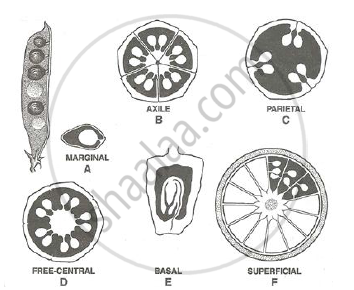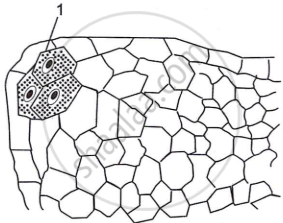Advertisements
Advertisements
प्रश्न
With the help of diagrams, name and describe the different types of placentation seen in angiosperms.
उत्तर
Different types of placentation seen in angiosperms.
Marginal Placentation : In this type, the gynoecium is monocarpellary, the ovary is unilocular and placenta are borne on the fused margins of the same carpel. The ovules are borne along the ventral suture of the carpel. This condition is found in legumes.
Axile Placentation : In this type of placentation the gynoecium is multicarpellary, syncarpous and the ovary is multilocular. The placenta are borne on fused margins of the same carpel. The ovules are borne on confluent margins which meet on the central axis. This type of placentation is found in tomato, Citrus, china
rose, etc.
Parietal Placentation : In this type, the gynoecium is multicarpellary, syncarpous and the ovary is unilocular. The placenta are borne on fused margins of the same carpel. This type of placentation occurs in watermelon and other cucurbits.

Free-central Placentation : In this type, the gynoecium is multicarpellary, syncarpous, and the ovary is unilocular. The ovules, appear to arise from the central column. This type of placentation is found in Dianthus Primula, etc.
Basal Placentation : In this type, the ovary is unilocular and the solitary ovule appears to arise from the base of the ovary as in sunflower.
Superficial Placentation : In this type of placentation, the gynoecium is multicarpellary and syncarpous and most of the internal surface of the ovary wall is covered with ovules, as in water lily.
APPEARS IN
संबंधित प्रश्न
Why is non-cyclic photo phosphorylation considered as a non-cyclic pathway?
If the haploid number of chromosomes in a plant species is 20, how many chromosomes will be
present in the cells of the shoot tip?
Define: Actinomorphic symmetry
Draw a neat labelled diagram of L.S. of anatropous ovule.
Discuss the role of cambium in the secondary growth of dicot stems.
Draw a neat labelled diagram of the vertical section of a monocot leaf.
The figure given below shows the early stage of the development of microsporangium.

Name the hypodermal cell labelled '1' which divides periclinally.
Draw a neat and well labelled diagram of T.S. of the mammalian ovary.
| Meena had grown Rose and China-rose plants in her garden. She collected pollen grains from China-rose plants and sprinkled them on the stigma of the Rose flowers, as she wanted to grow a hybrid variety of Rose. |
- Will this pollination give the desired results? Give a reason for your answer.
- What is geitonogamy? Why is it considered equivalent to cross-pollination in ecological context and self-pollination in genetic context?
